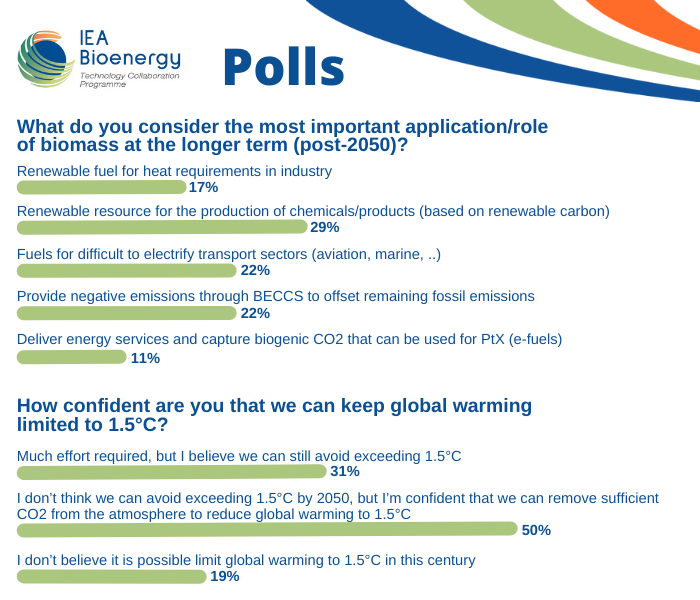The COP26 Climate Change Conference was recently concluded. Many countries and regions in the world aim to reach carbon neutrality by 2050 or even earlier. The COP emphasized the sense of urgency and the need for short term action to turn the tide on climate change.
Actions in the next decade will have a strong impact on future pathways to limit climate warming, with the post-COVID recovery being an inherent part of this. Strengthened climate action will imply an increasing role for sustainable biomass: as renewable energy source for different sectors; providing renewable carbon in the biobased economy; and providing options for negative emissions.
The implications of what the path towards carbon neutrality means for further deployment in bioenergy and the biobased economy will be discussed in this opening panel of the conference.
Welcome & Introduction
Paul Bennett, Chair IEA Bioenergy TCP, SCION, New Zealand
Keynote presentations
![]() Andy Reisinger, IPCC Vice-chair WG III, IPCC Intergovernmental Panel on Climate Change, New Zealand
Andy Reisinger, IPCC Vice-chair WG III, IPCC Intergovernmental Panel on Climate Change, New Zealand
![]() Paolo Frankl, Head Renewable Energy Division, IEA International Energy Agency, France
Paolo Frankl, Head Renewable Energy Division, IEA International Energy Agency, France
Panel Debate
Moderator
Paolo Frankl, Head Renewable Energy Division, IEA International Energy Agency, France
Panelists![]() Maria Georgiadou, Senior Expert – Renewable energy R&I policy, European Commission, DG Research and Innovation, Belgium
Maria Georgiadou, Senior Expert – Renewable energy R&I policy, European Commission, DG Research and Innovation, Belgium
![]() Dolf Gielen, Director of the IRENA Innovation and Technology Centre, IRENA International Renewable Energy Agency, Germany
Dolf Gielen, Director of the IRENA Innovation and Technology Centre, IRENA International Renewable Energy Agency, Germany
![]() Jim Spaeth, Chair Biofuture Platform, US Department of Energy, United States
Jim Spaeth, Chair Biofuture Platform, US Department of Energy, United States
![]() Jossy Thomas, Industrial Development Officer, UNIDO United Nations Industrial Development Organization, Austria
Jossy Thomas, Industrial Development Officer, UNIDO United Nations Industrial Development Organization, Austria

Highlights of the session
- A portfolio of options will be needed to limit climate change; there are no silver bullets and we don’t have the luxury to dismiss good options.
- Considering the current country pledges (NDCs) it is unrealistic to expect that 1.5°C warming can be reached without overshoot. Actions and targets for 2030 and 2050 need to be considered as a start for sustained efforts. Every 0.1°C counts!
- Next to deep and rapid reductions of CO2 emissions (through efficiency measures, replacing fossil fuels by renewables, …), CO2 removal from the atmosphere (CDR) will be absolutely necessary to limit global warming. Bioenergy combined with stable geological storage of carbon (BECCS) is one of the critical CDR options.
- The role of bioenergy in net zero scenarios is substantial – up to 20% of total energy supply in 2050 at the global level, based on realistic sustainable biomass potentials. Deployment of modern bioenergy in buildings (replacing traditional bioenergy), in industries and for transport biofuels can happen at the short-to-medium term but is not on track and needs much more efforts (which is also valid for many other decarbonisation options we need). Clear targets as well as supporting and de-risking the financing of first-of-a-kind commercial projects, e.g. through the European Innovation Fund, can give a push to deployment.
- We need to act quickly to phase out ‘traditional biomass’, meaning inefficient burning of biomass, associated with high toxic emissions, mostly in developing countries. This will not be an easy task as it comes with important social challenges. Switching to bio-ethanol for clean cooking in developing countries can have many advantages. Relevant initiatives are setup by UNIDO, e.g. in Tanzania, to create favourable market conditions and promote private sector engagement.
- Bioenergy comes with its challenges, stemming from uncertain availability and/or sustainability of biomass feedstocks. A joint understanding is important on the availability of sustainable biomass feedstock and how bioenergy pathways can be developed in a sustainable way. Biomass supply is cross-sectoral and needs to be actively integrated in land, forest or waste management, and, next to trade-offs, it can deliver important co-benefits, e.g. in supporting rural employment and reducing land degradation.

Recording


